— Thomas M. Tuerke
If you look at a typical model Japanese building, say one of the many offerings by Tomytec, you could be forgiven if you came to the conclusion that the models were deliberately "compressed" or foreshortened.
Turns out that's not necessarily so. There are many precedents—many buildings that really are that compact—to be found in Japan. It stands to reason, given that property prices are quite high. Not every building has as petite a footprint as the models', but neither is such a small building a rarity.
Here are just a handful of examples...
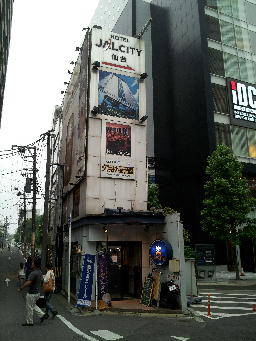 | Here is an excellent specimen found just north of the JR station in Sendai: five floors tall, and about a dozen feet wide. The ground floor is occupied by a small restaurant (a yakitori place if memory serves.) At first I thought this was the Hotel JAL City, but it turns out that's just a billboard; that hotel is actually off to the right somewhere; the rest of the building seems to be occupied by the Miyagino Kanko Bus Travel Center. |
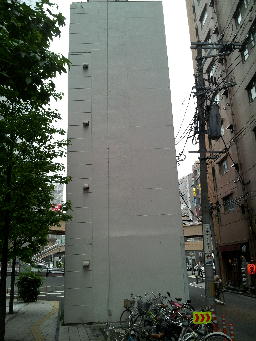 | Just in case there's any doubt, this is the rear of the same establishment. |
This part of Sendai—being stone's throw from the JR station—is fairly metropolitan, and many of the buildings are actually quite "conventionally sized." However, in nearby Shiogama (a coastal community, though not without its own little industrial district) there are many buildings that one might categorize as small.
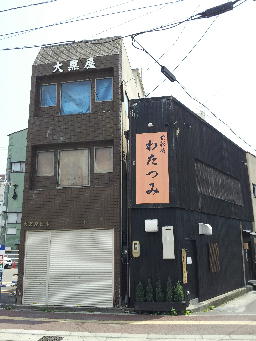 | Notice these two specimens. The width of the building on the left is that of a one-car garage plus a door, or roughly 15 feet. Though it's not clear from this picture, it's only about 30 feet deep, too.
Next to it is another building, roughly trapezoid in shape. The narrow facing side is roughly six feet wide, while the other (far) end is approximately 18-20 feet. Not very big at all. |
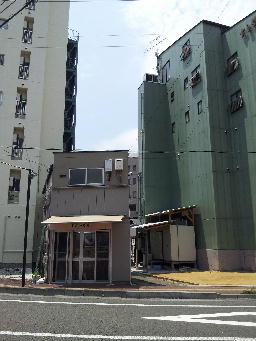 | This pocket-sized restaurant is also on the order of a dozen feet wide. Note, too, that the lot is oblique (you can see some of the building off to the left side.) Consequently, the frontage we see is actually a bit wider than the building is. |
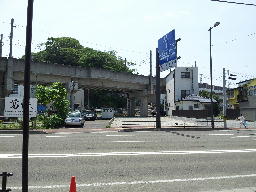 | A lone building next to the JR tracks. Remember that this area was inundated by the tsunami back in 2011, and according to one shop-keeper, the water came up about 4-5 feet. There were numerous empty lots in the area—fairly uncharacteristic—presumably where buildings once stood before the water rose. |
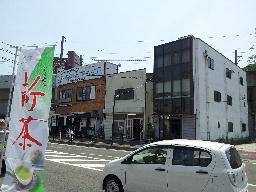 | The following two pictures are a threesome of buildings from different angles. The orange brick building on the left has a fairly wide frontage, but note that it is not very deep with the JR elevated right-of-way behind it. The smoked-glass building on the right is not very wide but considerably deeper, owing to the angle of the street in relationship to the JR track. |
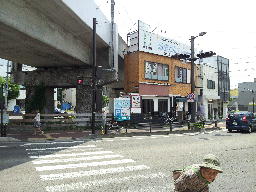 |
— Thomas M. Tuerke
As mentioned, space is at a premium in Japan, so it stands to reason the Japanese have figured out how to save space when it comes to their motor vehicles.
I'm not just talking about small cars, either. True, in Japan, the Prius is actually a fairly large car (think in terms of Smart and Mini Cooper for more typical size range) and even the delivery vehicles are more diminuative (I saw a small box-truck restocking a local 7-Eleven store where the box was roughly a six-foot cube )... you will not find bigger American vehicles like SUV's driving around. For one thing, they don't have the turn radius necessary for most places.
Instead, the whole notion of parking is frequently quite different. Parking lots are only about 50% efficient, if you consider the need for lanes, and ramps to adjacent floors, and widened places for turning, etc. Nope, that won't do in Japan. A simple affordance (one actually seen recently here in the states, too) is double-deck parking. Think of it as bunk-beds for cars. Hydraulics raise and lower the upper deck.
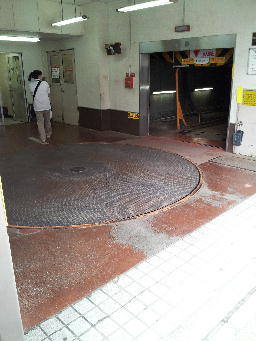 |
When truly necessary, efficient parking reaches new levels of compactness, like "parking carousels". Imagine driving into such a parking garage. You're on a metal turntable, and either in front of you, or to one side, is a car-sized opening onto what looks like a mechanic's car lift. Your passengers get out, and you drive onto the two rails before getting out yourself. Lock the door, and the attendant rotates the carousel to open up another space. Upon your return, the carousel brings your car to the landing spot, and you drive it out onto the turntable, enabling you to face the street again.
This is not to say that western-style parking structures don't exist—they do—but this manner of parking is quite common... and more to the point, is a great modeling detail that says "This is Japan" ... in a very small space. Such structures are attached to (or frequently between) some of the smaller high-rises.
Oh, and here's a humorous little aside. Given that most cars are quite small, it seems silly to have disproportionately large garage doors. In the structure shown in this photo, the garage door is five-feet-something in height (I would bang my head if I were to walk through.) The door to the left is more conventionally sized.
— Thomas M. Tuerke
It's been a while, so I thought I'd revisit this page.
Ultimately, what you choose to model will be influenced by more than expense—the region of the world you model has to stir something inside of you—but I've come to realize that modeling Japan is, comparatively speaking, much easier and cost-effective than... well, a few other places.
Okay, some back story. In the intervening years, I've had the opportunity to travel to Europe for business. In particular, the UK and Germany. Both have quite well-established rail networks, and I've been able to get around in large part thanks to an integrated rail system.
Take, for example, the UK, where you can book a ticket online, print it up, and show up at a railway station with that in hand. Comfortable, and reasonably reliable. I stress the word reasonably because I did hear a number of delay announcements, and in one case, I was delayed for nearly an hour owing to an accident up-stream whence my train was to come from.
But getting a model of the Class 390 Pendolino sets is nigh on impossible. I did find a fellow who was crowd-sourcing the funding of one of these, but fell short. He did say that Rapido had come through with a commitment, but it's a special pre-order. The price of a DC system 9-car set is in the neighborhood of $450. The 11-car set, closer to $500. MSRP.
The short take-away: a limited market, to the point that limit run special orders are necessary... for the backbone of the UK fleet.
In contrast to, say, a series 500 8 car set runs you below $200, and a Hokuriku W7 6-car basic set in the $140 range... probably less if you shop around.
In other words, the volume of sales is high enough to have prices reasonably low, but there's an insane diversity of models available.
Traveling to Germany, I found something similar to the UK. (And as a German, I find this hard to say...) the DB was—again—reasonably reliable, but falling far short of that clockwork precision I was expecting from DB (but could count on from JR.) A fair bit more diversity in rolling stock.
But it was still hard to find models available.
What I did find was insanely expensive: $250 for a single N scale locomotive (the comparison would be a $60 JR-prototype locomotive) ... although I have to admit that comparison is a bit unfair: the former had a DCC controller in it ... but if you're not doing DCC, this is a silly-ridiculous premium to pay for something unwanted. Why, though, should a little card triple the price of the loco? Moreover, apparently it's a semi-proprietary board. Fun, DCC has flavors, and they don't always play nice together.
I did, later, find a stateside vendor with a pretty nice selection, and a thriving community forum behind it, too... which is goodness. The prices there are a bit more reasonable... so... nice.
At least for Europe, you have some options.
But (to me, anyway) there's something missing. Travel by rail is not nearly as core to either national identity as it is with Japan, so travel by rail doesn't have quite the same chic, and as a result, the numbers of modeling railfans aren't quite as high, either.
Which is too bad.
Anyway, I enjoyed my travel, but I'm quite sure I'll stick with modeling Japan. Though—shhh—I'm contemplating at least one module with a European theme, thanks to some Kibri models picked up in Rothenburg (that's right: the only hobby shop I found on the trip, I found in that Town that Time forgot) The thing is, this would be easy to explain, even on a Japanese layout, given the fact that Japan has a Dutch Town theme park... and a dedicated train to take you there.
Yeah... Japan. Always fun to model.
— Thomas M. Tuerke
Youtuber Thoughty2 sums up the Shinkansen thusly. Though his animations depict the modern Series 700 even as he describes the original (retro-named) Series 0, he still catches the spirit of Japanese rail...



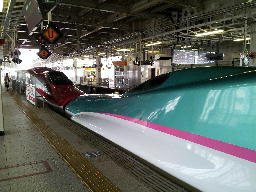
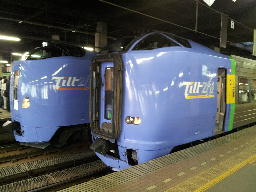
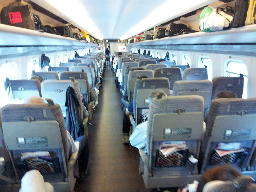
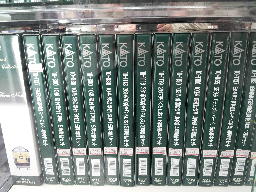
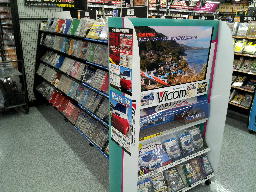
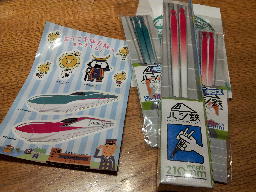







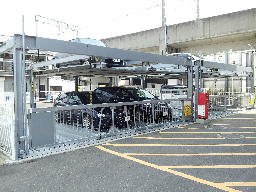

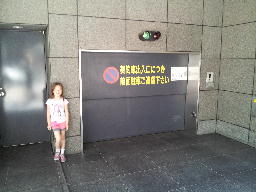
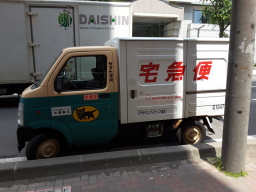
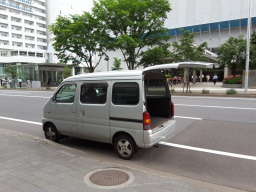


 Generate a QR code link to this page
Generate a QR code link to this page